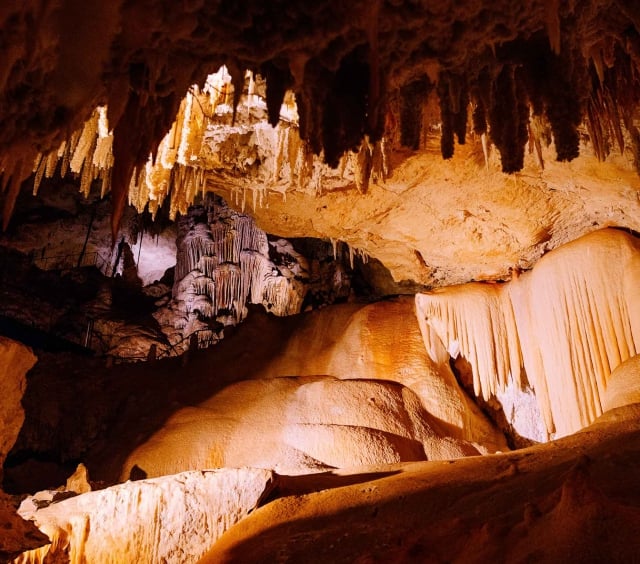
Located 10 minutes north of Augusta, Jewel Cave is the largest show cave in Western Australia and also the most recently developed. It is named after the Jewel Casket, a small chamber in the lower sections of the cave. The cave was opened to the public on the 26th December 1959.
Although the existence of a small hole “Wind Hole” was known of in the early 1900’s, it was not rediscovered until 1957 when Cliff Spackman and others came upon a small hole in the ground which had a strong draft of air blasting out of it. Cliff was lowered into the cave during January 1957. Descending 12 metres through a solution pipe into a large chamber he reached a soil cone another 8 metres below the ceiling. In February 1958 Cliff Spackman, Lloyd Robinson and Lex Bastian continued the exploration, discovering more than 2kms of cave passage. The cave has a depth of 42 metres, with the floor being approximately 24 metres above sea level.
Jewel Cave is located in a limestone area approximately 90 kilometres long and 3 kilometres wide known as the Leeuwin-Naturaliste Ridge. The limestone (Aeolian calcarenite), which forms the Leeuwin- Naturaliste Ridge was formed from coastal sand dunes when westerly winds along our coastline blew beach sand, sea-shells and corals into huge sand dunes during the last million years. The sand has been cemented together to form limestone by the action of rainwater. A speleothem, or cave decoration, from Jewel Cave was dated at 466,000 years old. The uranium-thorium dating establishes a minimum age for speleothem development within the cave – hence the deposition of the limestone must predate this, presumably by a considerable amount. However a sample of limestone was taken from the basal marine unit in Jewel Cave and yielded an age of 780,000 years through thermo-luminescence dating. This data suggests that the limestone may be older than Middle Pleistocene (approximately 1 million years ago).
A huge chamber is encountered as you enter the cave and several tree roots can be seen spiraling down from the roof as you reach the top platform. The trees above (karri and marri) are sending their tap roots down into the depths looking for moisture within the cave.
The cave decorations in these limestone caves are made from calcite, a crystalline form of calcium carbonate. Jewel Cave contains one of the longest straw stalactites to be found in Australia. This straw is 5.43 metres long. Straws are hollow tubular stalactites whose diameter varies with the diameter of a water droplet (approximately 2 to 9mm). Jewel Cave is an extremely well decorated cave, it contains many examples of helectites, a very large stalagmite called ‘The Karri Forest’, cave coral, pendulites and beautiful examples of flowstone such as ‘The Frozen Waterfall’ and ‘the Organ-pipes’.
The skeleton you can see in the Jewel Casket is a Brush-Tailed Possum, which has been dated by radio carbon techniques to be 400-500 years old. A Tasmanian Tiger (Thylacinus cynocephalus) skeleton was also discovered in June 1960. At this stage the youngest dated Tasmanian Tiger (Thylacinus cynocephalus) in Western Australia is a specimen from Murra-El-Elevyn Cave on the Nullarbor dated at around 3,200 – 3,400 years old.